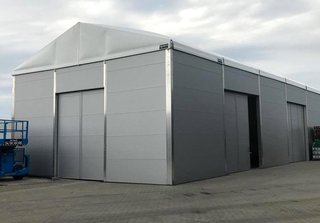Temporary Buildings: The Versatile Solution for Modern Needs
Wiki Article
In an ever-changing world where flexibility and efficiency are paramount, temporary buildings have emerged as a practical and innovative solution for a wide range of applications. From construction sites and event venues to emergency shelters and pop-up retail spaces, these structures provide a cost-effective, adaptable, and sustainable replacement for traditional permanent buildings. Whether you need a short-term workspace, additional storage, or a quick reply to an unexpected situation, temporary warehouse building provide the perfect answer.
What Are Temporary Buildings?
Temporary buildings, also called modular or semi-permanent structures, are prefabricated units created for quick assembly, disassembly, and relocation. They are typically created from lightweight yet durable materials including steel, aluminum, and high-quality fabric or PVC. These buildings might be customized in space, shape, and functionality in order to meet specific needs, making them ideal for a variety of industries and purposes.

Key Benefits of Temporary Buildings
Cost-Effectiveness
One of the very most significant features of temporary buildings is affordability. Compared to traditional construction, these structures require a shorter period, labor, and materials, causing lower upfront costs. Additionally, they may be rented or leased, providing a flexible type of financial selection for businesses and organizations with limited budgets.
Quick Installation
Temporary buildings may be erected in just days and even hours, with regards to the complexity with the design. This rapid deployment is especially valuable in situations where time is from the essence, for example disaster relief efforts or urgent storage needs.
Flexibility and Adaptability
Whether you need a small office, a large warehouse, or a multi-purpose event space, temporary buildings might be tailored to fit your requirements. They can be also easily expanded, reconfigured, or relocated since your needs evolve, offering unparalleled flexibility.
Sustainability
Many temporary buildings are made with sustainability in your mind. They often use energy-efficient materials, incorporate natural lighting, and can be reused or recycled, reducing their environmental impact. This makes them an eco-friendly choice for businesses and organizations aiming to minimize their carbon footprint.
Temporary or Semi-Permanent Use
As the name suggests, temporary buildings are suitable for short-term needs. However, they could also function as semi-permanent solutions, providing durable and reliable spaces for extended periods. With proper maintenance, these structures takes years, driving them to a versatile selection for various applications.
Common Uses of Temporary Buildings
Construction Sites
Temporary buildings are popular in the construction industry to provide on-site offices, storage facilities, and worker accommodations. Their portability and quick and easy installation make them a vital part of any construction project.
Event Spaces
From industry events and exhibitions to weddings and concerts, temporary buildings offer a quick and customizable solution for event organizers. They might be designed to accommodate large crowds, provide catering facilities, or work as VIP lounges.
Emergency and Disaster Relief
In the aftermath of natural disasters or humanitarian crises, temporary buildings play an important role in providing emergency shelters, medical facilities, and storage for relief supplies. Their rapid deployment can conserve lives and support recovery efforts.
Retail and Pop-Up Shops
Temporary buildings are increasingly popular within the retail sector, particularly for pop-up shops and seasonal stores. They allow businesses to test new markets, promote products, and build unique shopping experiences minus the commitment of a long-term lease.
Education and Healthcare
Schools, universities, and healthcare facilities often use temporary buildings to cope with space shortages or accommodate renovations. These structures can work as classrooms, laboratories, clinics, or administrative offices, ensuring continuity of services.
Industrial and Warehousing
Businesses in need of additional storage or workspace can be helped by temporary buildings. They provide a cost-effective solution for expanding operations, housing equipment, or managing inventory.
Choosing the Right Temporary Building
When picking out a temporary building, consider the following factors:
Purpose: Determine the key use of the structure (e.g., office, storage, event space) to make certain it meets your requirements.
Size: Choose a size that accommodates your preferences while permitting potential future expansion.
Durability: Opt for high-quality materials that can withstand the intended use and environmental conditions.
Customization: Look for suppliers that offer customizable features, such as insulation, lighting, and flooring, to improve functionality and comfort.
Budget: Compare costs and explore rental or leasing options to find a solution that fits your financial budget.
The Future of Temporary Buildings
As technology and design continue to advance, temporary buildings are getting to be more sophisticated and versatile. Innovations such as smart building systems, eco-friendly materials, and modular designs are expanding the number of choices for these structures. In a world where adaptability and sustainability are increasingly important, temporary buildings are poised to play a vital role in shaping the way forward for architecture and construction.
Temporary buildings are more than just a stopgap solution—they really are a testament to human ingenuity and adaptability. Whether you’re addressing a short-term need or seeking a versatile, long-term solution, these structures provide a practical, cost-effective, and sustainable option to get a wide range of applications. From construction sites and event venues to emergency relief and retail spaces, temporary buildings are redefining the way we think about space and functionality.